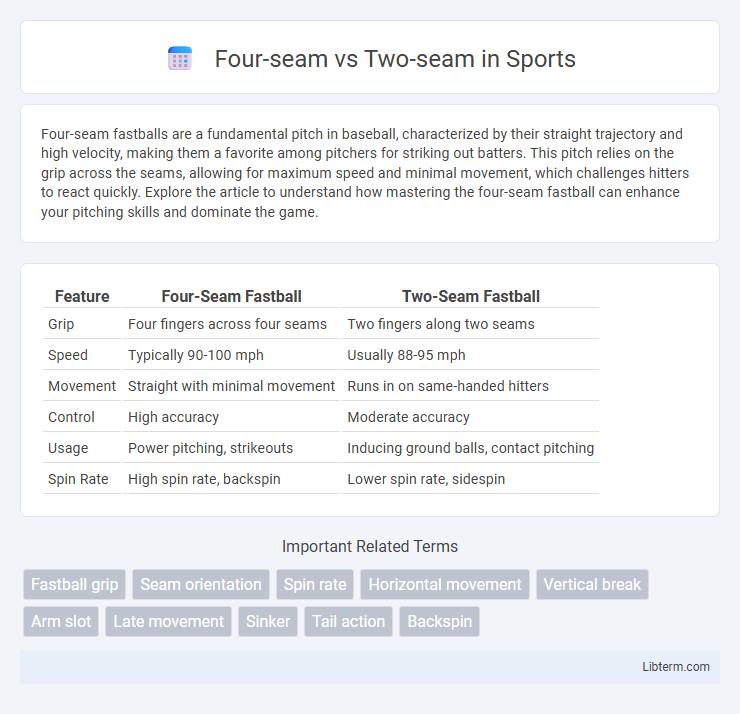Four-seam fastballs are a fundamental pitch in baseball, characterized by their straight trajectory and high velocity, making them a favorite among pitchers for striking out batters. This pitch relies on the grip across the seams, allowing for maximum speed and minimal movement, which challenges hitters to react quickly. Explore the article to understand how mastering the four-seam fastball can enhance your pitching skills and dominate the game.
Table of Comparison
| Feature | Four-Seam Fastball | Two-Seam Fastball |
|---|---|---|
| Grip | Four fingers across four seams | Two fingers along two seams |
| Speed | Typically 90-100 mph | Usually 88-95 mph |
| Movement | Straight with minimal movement | Runs in on same-handed hitters |
| Control | High accuracy | Moderate accuracy |
| Usage | Power pitching, strikeouts | Inducing ground balls, contact pitching |
| Spin Rate | High spin rate, backspin | Lower spin rate, sidespin |
Introduction to Four-Seam and Two-Seam Fastballs
Four-seam and two-seam fastballs differ primarily in grip and movement, influencing pitch speed and rotation. The four-seam fastball is gripped across the horseshoe seam, producing maximum backspin and velocity, making it straighter and faster, often exceeding 90 mph. The two-seam fastball is held along the seams, generating more lateral movement and sink, resulting in a slightly slower pitch that can effectively induce ground balls.
Key Differences Between Four-Seam and Two-Seam
The four-seam fastball achieves higher velocity and a straighter trajectory due to its grip across the baseball's seams, optimizing backspin for less movement. In contrast, the two-seam fastball, gripped along the seams, generates more lateral and sinking movement by creating increased drag and less backspin. Pitchers choose four-seam for pure speed and strikeouts, while the two-seam is favored for inducing ground balls and control.
Grip Techniques: Four-Seam vs Two-Seam
Four-seam fastballs offer a firm, consistent grip with fingers aligned across the horseshoe seam, maximizing backspin and velocity. In contrast, two-seam fastballs require a grip along the narrow seams, allowing increased finger pressure that produces lateral movement and sinking action. Pitchers choose gripping techniques based on desired ball behavior, optimizing control for precision or movement for deception.
Pitch Movement and Trajectory Comparison
The four-seam fastball exhibits a straighter, more backspin-driven trajectory with a consistent velocity, resulting in a rising illusion that challenges hitters. In contrast, the two-seam fastball features greater lateral movement and sink due to its grip and pronation, causing the ball to tail toward the pitcher's throwing arm side. These distinct pitch movements and trajectories influence batter timing and swing path, making each pitch effective in different game scenarios.
Velocity Differences: Which One is Faster?
The four-seam fastball typically reaches higher velocities than the two-seam fastball, often averaging 2-5 mph faster due to its straighter spin and grip mechanics. Pitchers utilize the four-seam grip to maximize speed and backspin, producing a rising effect and reduced air resistance. In contrast, the two-seam fastball, with its pronated grip and greater side spin, sacrifices some velocity for enhanced movement and sink.
When to Use Four-Seam vs Two-Seam
Four-seam fastballs offer maximum velocity and straight trajectory, making them ideal for challenging hitters and setting up breaking pitches. Two-seam fastballs provide more movement with slight tailing action, useful for inducing ground balls and weak contact in low-pressure counts. Pitchers often choose four-seam for strikeouts and two-seam for situational pitching focused on control and ball movement.
Advantages and Disadvantages of Each Fastball
Four-seam fastballs offer higher velocity and straighter trajectory, making them ideal for overpowering hitters and generating strikeouts. Two-seam fastballs provide more movement and sink, increasing ground ball rates but sacrificing some speed and control. Pitchers benefit from mixing both pitches to confuse batters, balancing speed with movement to enhance overall effectiveness.
Common Mistakes with Four-Seam and Two-Seam
Common mistakes with four-seam fastballs include overusing the pitch, leading to reduced velocity and predictability, and improper grip that causes inconsistent control and reduced movement. For two-seam fastballs, pitchers frequently struggle with poor finger placement, resulting in diminished sink and lateral movement, and mishandling the pitch's trajectory, which often leads to increased hittability. Proper mechanics and consistent practice are essential for maximizing effectiveness and minimizing errors when throwing both four-seam and two-seam fastballs.
Notable Pitchers and Their Signature Fastballs
Notable pitchers such as Gerrit Cole and Justin Verlander are renowned for their explosive four-seam fastballs, which generate high velocity and a straighter trajectory, often exceeding 95 mph. In contrast, two-seam fastball specialists like Joe Musgrove and Lance Lynn utilize their pitch's natural tailing movement to induce ground balls and weak contact, typically throwing in the low 90s. These signature fastball grips significantly impact pitching strategies by balancing velocity and movement to maximize effectiveness against hitters.
Tips for Mastering Both Fastball Types
Mastering both four-seam and two-seam fastballs requires focusing on grip, release, and arm angle to maximize velocity and movement. For a four-seam fastball, place your index and middle fingers across the seams with a firm grip to achieve straight, high-velocity pitches. Two-seam fastball success depends on gripping along the seams and pronating the wrist slightly on release to create tailing movement, enhancing control and deception.
Four-seam Infographic

 libterm.com
libterm.com